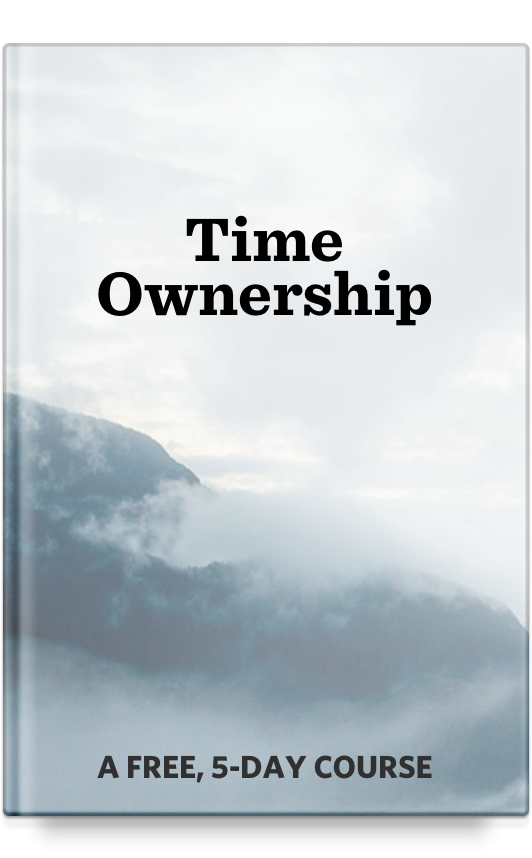This was my first year to attend Jeff Goins’ conference in Nashville: Tribe.
Tribe is a creative and business conference for writers. It was a delight to meet with so many folks from all spectrums of the writing world: from self-published authors, to bloggers, and more.
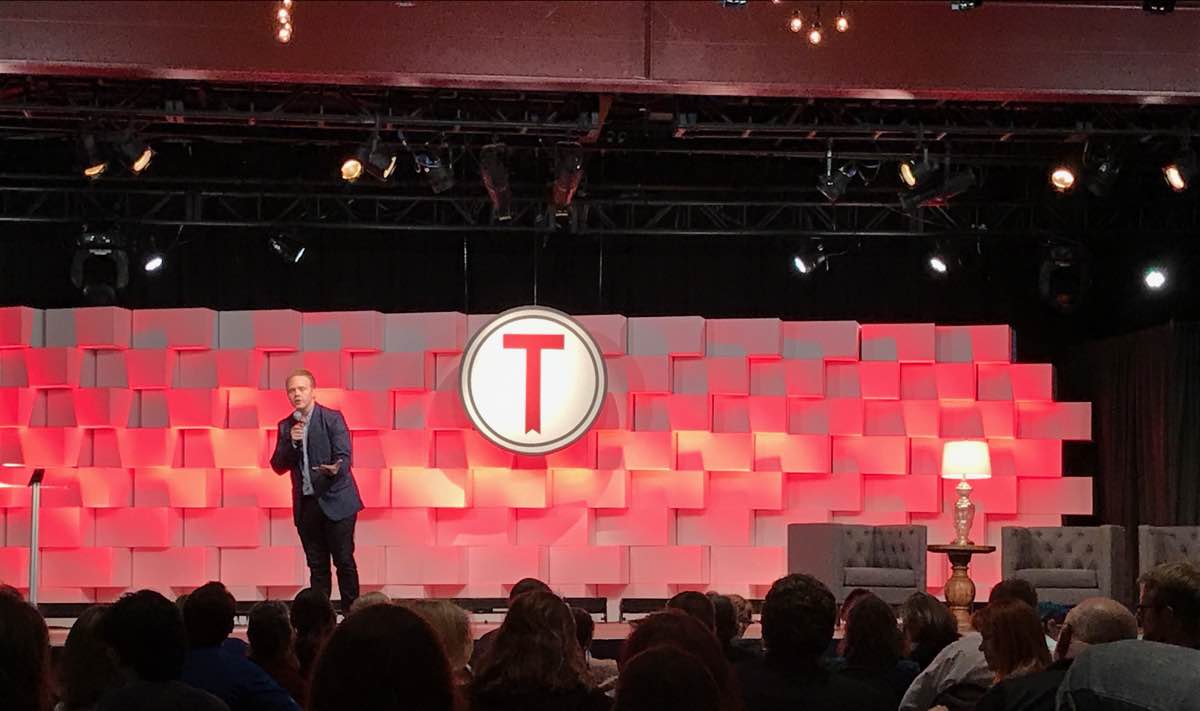
At the start, Jeff began the weekend issuing two challenges to everyone:
- Practice being an artist. Because sometimes you have to believe it until you become it.
-
Don’t starve. Meaning don’t assume that your gift requires you to suffer in order for you to share it. In other words, it’s okay to make money doing your art. (In the words of Derek Sivers, money is a neutral indicator of value.)
There was also an ever-present emphasis on focus and action. I know first-hand how easy it can be to talk about writing, to think about writing, to tweet about writing. But actually doing the work… not so easy.
The rules for the event were be present, be helpful, and be brave. Being brave meant to apply what you learned — to actually DO something. Take action.
Something Jeff said several times was to pick one thing from the conference that you will actually DO this month. At a conference, you can walk away with so many ideas and action items, that it’s overwhelming at where to start. So, consider the whole event a win if you can do just ONE thing that will move you closer to your goals.
As usual, during the event I took a ton of notes. Here they are for you. Hopefully you can find a fresh idea or tidbit of inspiration.
Pamela Slim
When you have something to launch, you are afraid and worried that nobody will buy. You’re wondering “where are my people?”
Those people — your beloved readers; your truest fans — live within a bigger ecosystem. And through your beloved readers you can impact the bigger ecosystem.
Your reader has a whole life. Where do they go? Where do they get help with their challenges and problems? Where do they hang out?
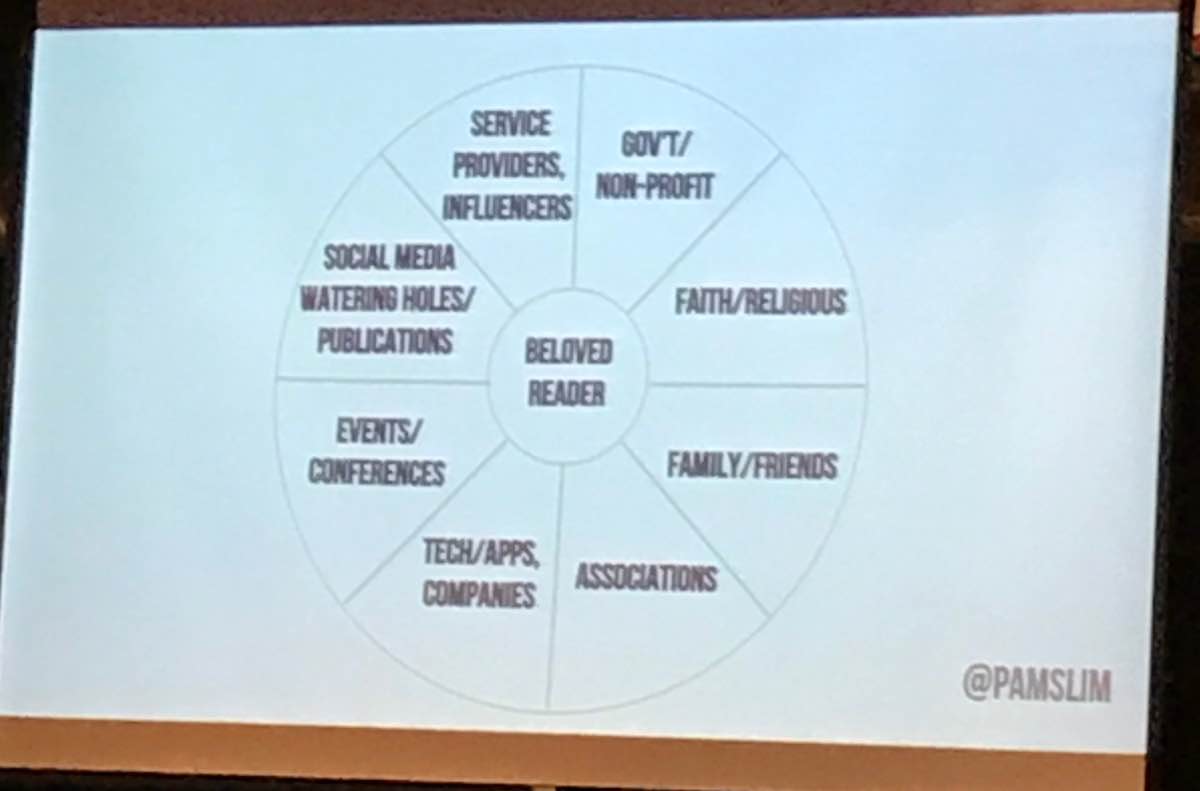
You cannot solve ALL the problems your reader has. Don’t be their messiah.
Your job is to give the very best of what you have.
Consider what problems your readers face around your topic, and what do they aspire to? Seek to serve them in those ways.
Do not define your audience by their demographics, define them by their problems. — Susan Baier
Who do your readers admire? What books do they read? Which conferences do they attend? Where else do they go to solve their problems?
If you want more readers, then be the weirdo in the room. Don’t go to a peer event to get customers. Instead, get out of your comfort zone and get into the space that your customers hang out. Don’t underestimate the 1:1 connection.
To build your audience:
- Know your message.
- Know your reader.
- Create “beacons” of your message in the places your reader hangs out.
What can you create and share that will solve your reader’s problems?
(Note from Shawn: What I loved about Pam’s talk is that she boiled things down to a simple focus: serve your readers. Solve their problems and help them. That simple focus is so liberating. We all have this big, blank canvas of “what shall I write about?” But if you seek to understand your readers and their challenges, then the answers of what to write about become clear.)
Ishita Gupta
Make your mess, your message. To find your voice, amplify your quirks.
We are all quirky and have goofy lives with bumps in the road, etc. Nobody has it all together. Share your mess and also share your message. The process is the gold.
Casey Neistat has built an audience because he’s willing to risk embarrassment and be himself. Confidence is built by being authentic over and over again until you finally get comfortable with it.
Tsh Oxenreider
Tsh was living in Turkey and was diagnosed with clinical depression. She needed a creative outlet, so she began a blog on simple living and it grew into a strong, sustainable audience. But then, she found herself working all the time.
After moving to Texas, her and her husband decided to do something “adventurous” — they wanted to travel. Was in a good season of life, due to the age of their kids (9, 6, 4) and the fact that her work was nimble and flexible due to the fact she was blogging.
To keep work nimble meant she had to begin saying no to anything and everything that wasn’t absolutely essential. She generated some margin in her work life so her family could begin traveling.
Their family spent a whole school year on the road and went to 30 countries.
Tsh had to find a way to work in the nooks and crannies. Was so afraid that the blog would implode at any moment because of how “unplugged” she was. But in truth, the fringe experience of her travels are what caused her website to grow even more. It was the best thing she’d ever done for her business.
By traveling…
- Tsh (and her whole family) gained more perspective and empathy.
- Got her out of a rut, and gave her new topics and stories to write about.
- Forced essentialism, and thus less decision fatigue. And that helped her be a better writer.
- It helped her to be more authentic and honest. And as a result, her audience grew and became more loyal.
For your platform and audience growth:
- Listen to your frustrations: What are the things you’re tired of doing simply because you “should” be doing them?
- Listen to your life: Pay attention to what matters to you. You have to be authentic and transparent with your audience, so if you’re not in tune with your own life then you won’t be able to be truly authentic.
- Dream and Scheme: Take a leap and make a plan. See what happens.
- Do something that breaks the rules. Challenge your status quo.
Sean McCabe
Of course, Sean had the most beautiful slides of anyone else.
What if you created as much as you consumed?
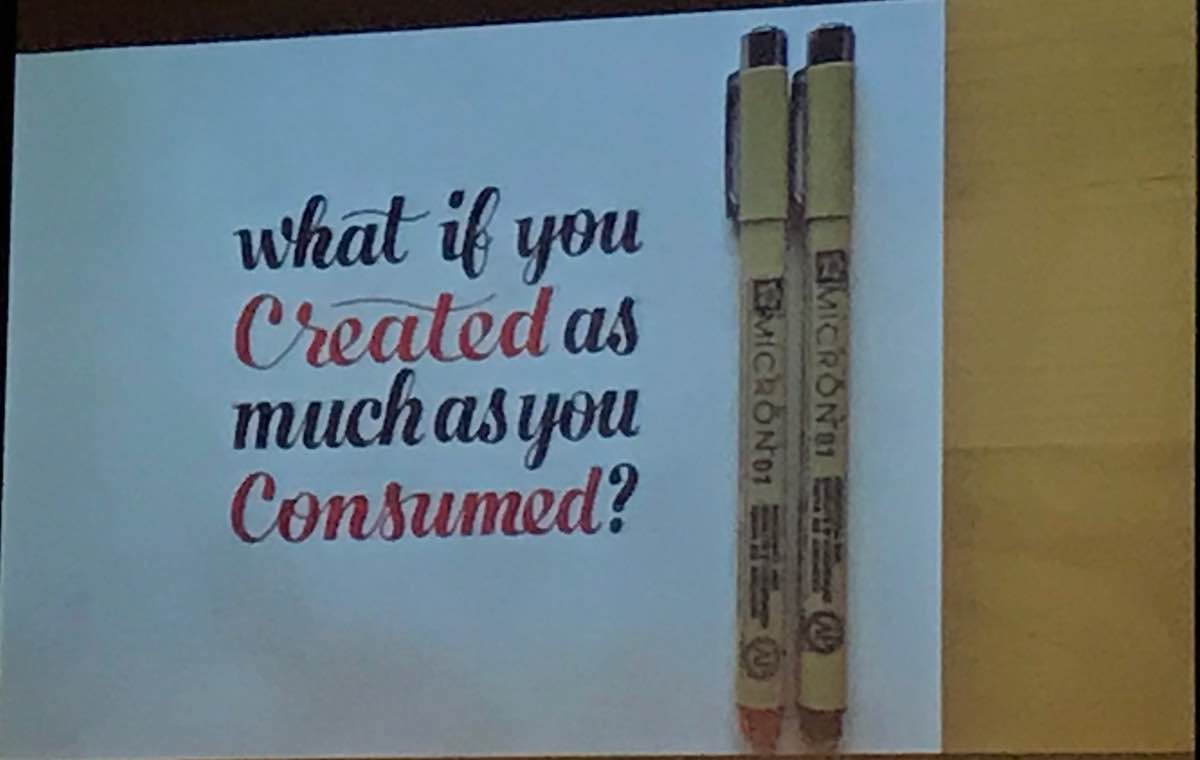
Show up every day for 2 years.
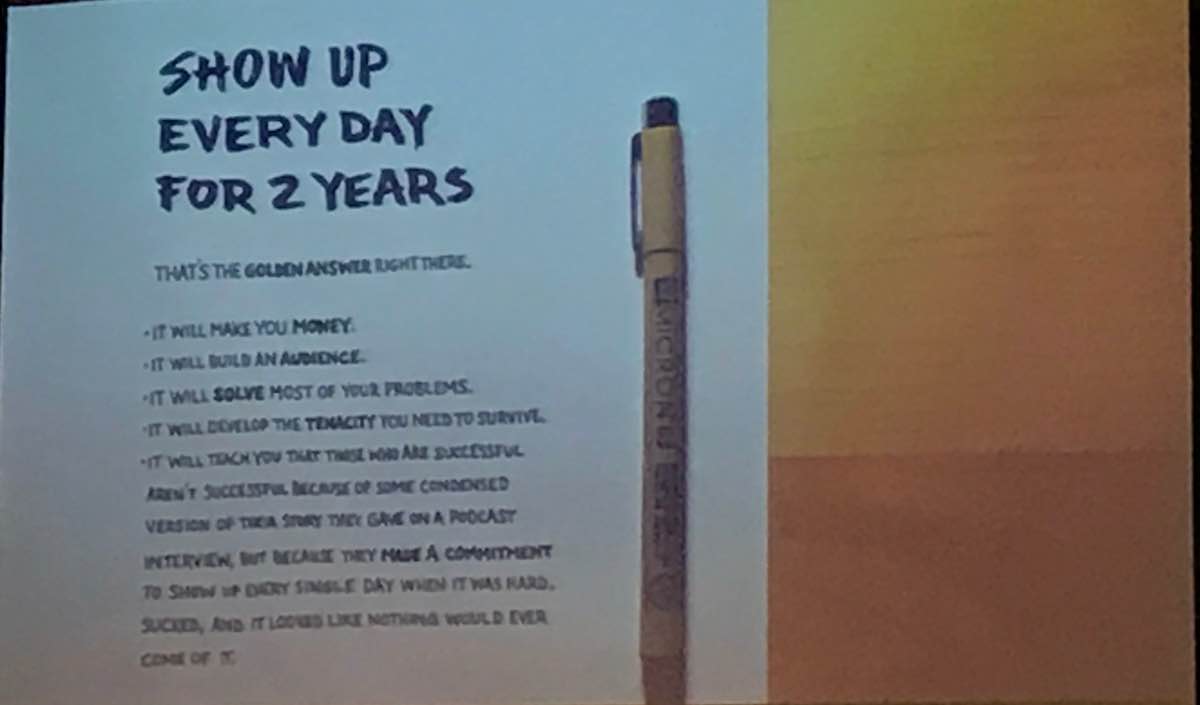
Sean spent 2 years, practicing hand lettering for 6-8 hours per day and putting his work online. Then, after those 2 years, he began getting traction in his work. Getting traction and getting noticed just takes time.
Fear of starting is holding so many people back.
Every step is forward progress. So many people hold back their writing because the words they’re putting on the page are not yet “perfect”. You can’t edit what you haven’t written. So just write.
Keys to Audience Building
- Curation (kind)
- Consistency (frequency)
- Quality (value)
- Time (patience)
Curation means you selectively project a single focused thing. You’re awesome, but people can’t process your awesomeness. People will simplify. They will put you in a box.
The first wave benefit of curation, is that people will think of your “thing” when they think of you. But the second-wave benefit of curation is when people encounter your “thing” in the world, and they think of you.
Time — Good work can be instantly recognize. But you have to make something remarkable. And then, make something remarkable again. And again. Show up every day. (And trust the process.)
Show up every day for 2 years, and any traction you get inside of 2 years is just considered a bonus.
Weekly publishing is how you stay relevant.
Daily publishing is how you stay top-of-mind.
Intentional practice: You don’t get better by accident. Doing your work is not the same as deliberate practice. Just because you’re showing up, doesn’t mean you’re intentionally getting better. You must identify problems, study your work, note your weak spots, find your bad habits, and improve them.
One way to improve your writing is to develop your “hybrid voice”.
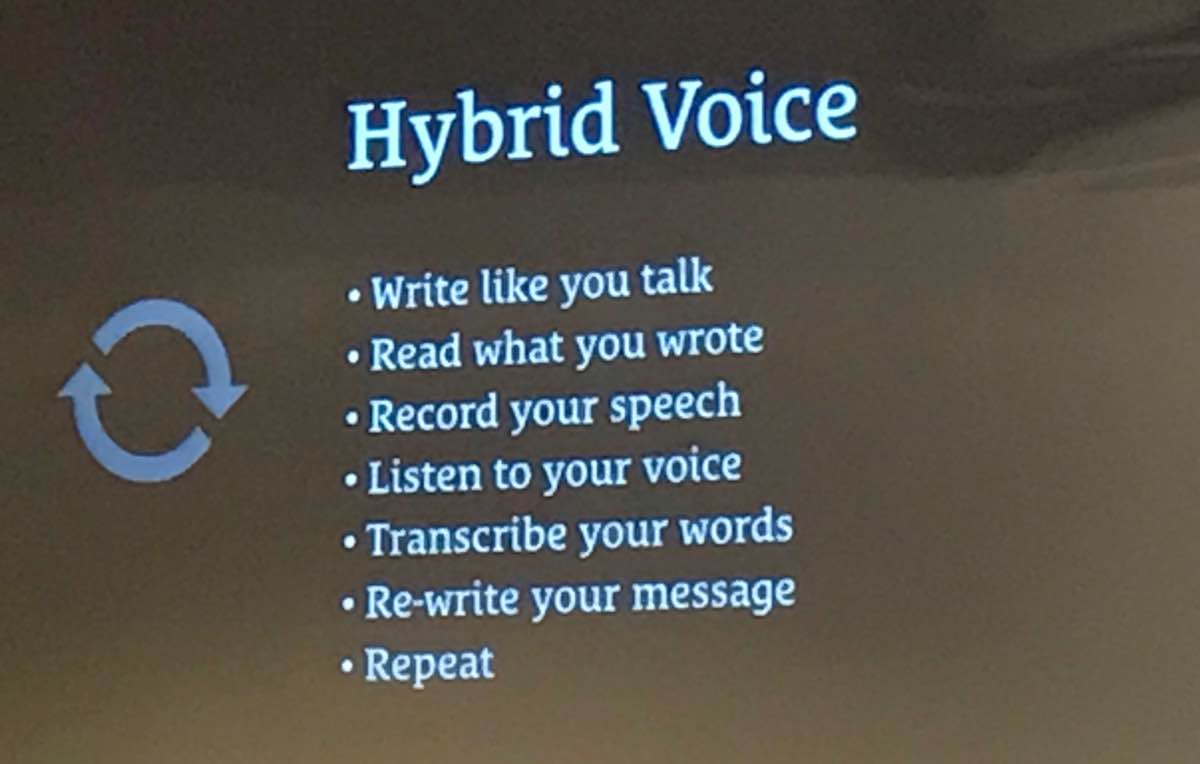
The secret to being inspired is to show up. Motivation is not the start, it is the result. You must start with a commitment, not an inspiration. Motivation comes after you show up.
(Note: See also my notes from Sean’s talk at the ConvertKit conference.)
Crystal Paine
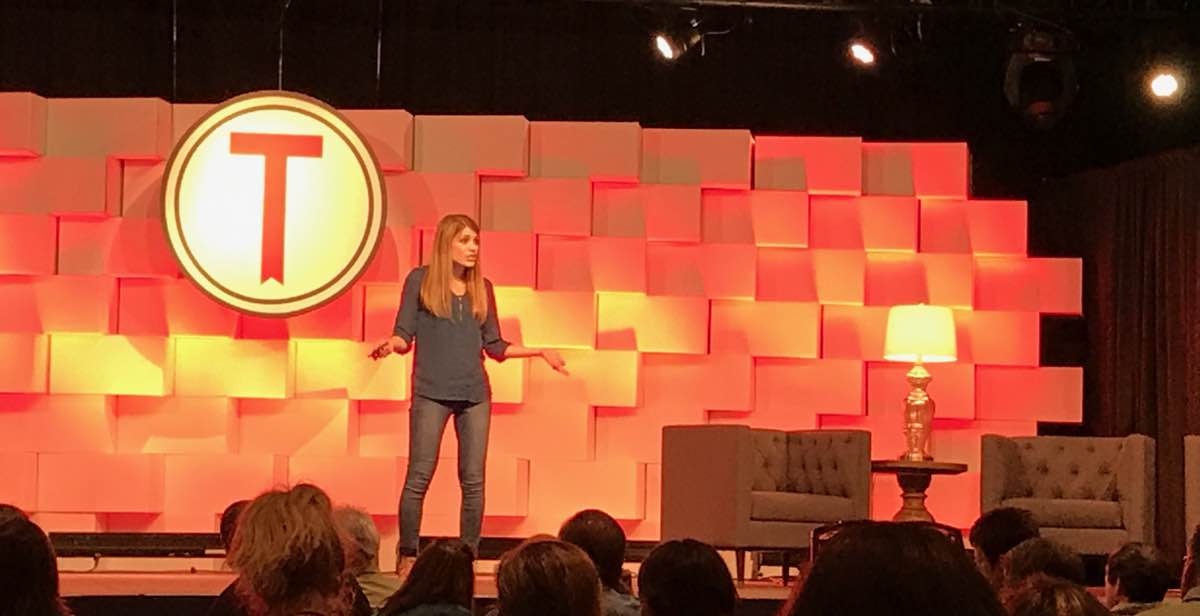
Crystal had grown her site to a 7-figure business with 2 million monthly unique visitors. But it became all consuming. So she pulled way back, and learned 3 counter-cultural lessons to grow your business without killing your life.
Ditch the hustle. What do you WANT to spend your time doing? Focus on that, and allow yourself the margin to stay healthy so you can do things for the long run.
Rest is the new hustle. If hustle is your plan for getting traction, then you don’t have the margin or clarity to focus on what matters and what works. You’re flailing and not being as effective. Breathing room will help you know what to focus on so you can work effectively.
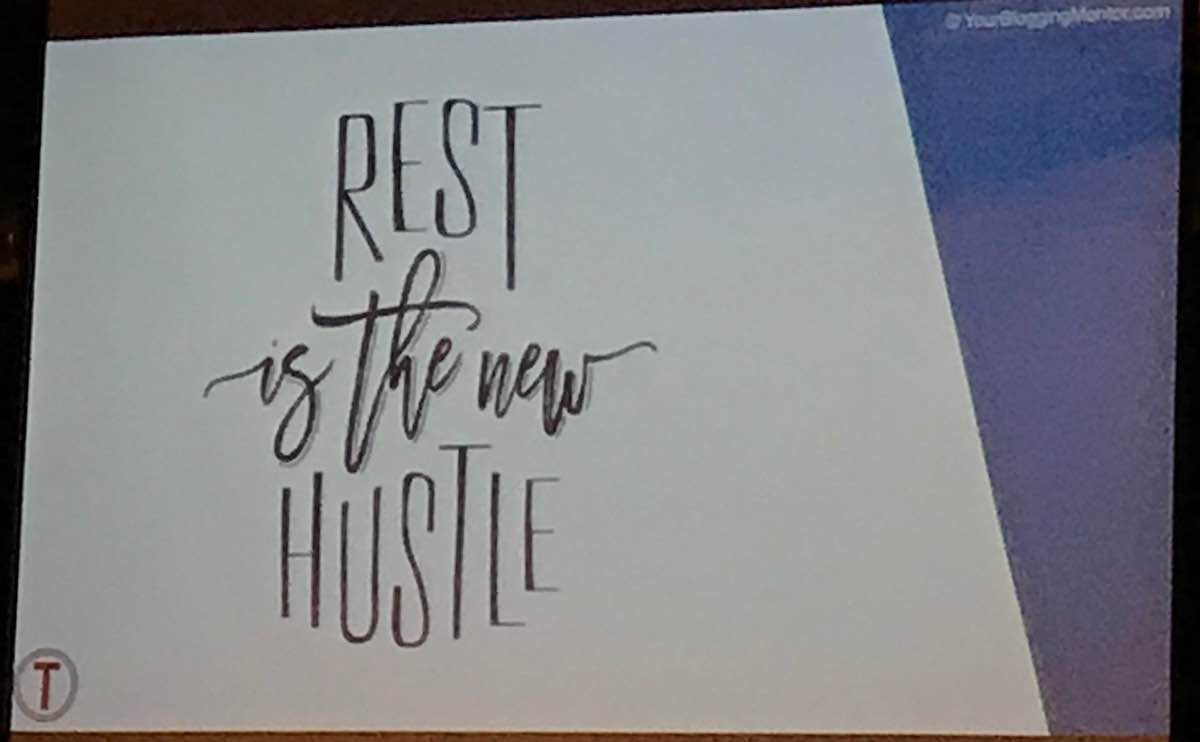
Determine Your Boundaries. Create a framework for your decision making (it’s like budgeting). You can’t multitask (like answer email and also make dinner and help the kids with homework).
Boundaries allow you to be all in for each thing you do. And they can help you know what is okay to say yes to and what you should say no to.
(Example from Shawn: I don’t do any business-related calls or guest podcast recordings after 5pm because the evenings are my family time.)
Dare to Focus and Finish. There are so many things that you feel you need to do or should do right now. But the truth is that you can’t do it all, and you especially can’t do it all right now.
Don’t get distracted by shiny things. Focus on only one project at a time and see it through to the end.
Each week, Crystal focuses on one area of learning and one task / project to complete. It’s far better to finish a few things than to start a bunch but finish nothing.
(My big takeaway from Crystal’s talk is that it’s doable to have a healthy balance between work and life and that both are important and valuable. But you can’t let one dominate to the point where you become unhealthy and stressed.)
Leo Babauta
In a rare, special appearance, Leo Babauta came to Tribe to speak!
- Change your life (from necessity and despair)
- Adventures in blogging (no idea what to do)
- Blogging Success (scared!) (a.k.a. Joyfear)
When Leo first began Zen Habits, he was writing all the time. He would comment on other websites, guest posted on many people’s sites, and was doing freelance writing for 5 other blogs. All in addition to writing everyday on his own website.
As his site began to get traction, there was a hope. There was a connection with other people who also had a similar interest and drive. And that hope gave him massive motivation.
Because of his background in journalism, he knew how to write great headlines and how to structure an article so that people could read it and take action.
At many of the most important moments of his life, he felt intense fear but also intense joy. He was terrified and delighted. He called that feeling: Joyfear. Joyfear means you have an event in your life where you are filled with joy and delight and excitement. Yet also absolutely terrified.
To build your website and audience, you need solitude, community, joy, and fear.
Your best work is done in solitude. Not just alone in a room, but alone with your work. Leo would get up early in the morning and create time for writing. He did it first thing in the morning because it was the first thing he did all day. He would unplug the internet in order to stay free from distractions.
Leo made himself write for a minimum of 10 minutes every day. And usually he’d write more than that. And during that time, he couldn’t do anything but write. He couldn’t even sit still… he had to write.
Connecting: Get to know your readers. Focus on their problems. Help as much as you can. Put yourself into their minds — what are they going through? Put them at the heart of every decision you make with your site. Also, connect with peers in your industry.
Joy: What gives you joy? Joy helps you push through fears, it gives you motivation to get up ad do the work, and grow your audience. Change lives and make a connection.
Fear: Overcome procrastination by allowing yourself into the groundlessness of uncertainty. Embrace the feeling of “uncertainty” and find the joy in the process and the journey.
Often, when we feel that fear, we return to comfort and negative patterns of behavior. Instead, choose to embrace the fear.
(Side note: see The Fight to Stay Creative)
How to build habits
- Have a Why and a passion that gives you motivation and vision.
- Have accountability (such as an audience)
- Start small (give yourself a low barrier of entry in order to get going)
- Set up a positive environment — most of us are in an environment that is hostile toward your positive, lifestyle changes and choices. So get rid of everything that distracts you and hinders you.
- Deal with your uncertainty. Embrace it and don’t back down because of it.
Takeaways: Step into your uncertainty. Let yourself be moved by love.
Dan Miller
Take 3-5% of your income and use it to invest into itself. At least 3% but 5% when you can afford it.
Use that money to buy books, online courses, attend events, etc. Use it to invest in yourself — to continue learning.
Many of those things you can get for free online or at a library. But try to pay for your personal development in order to put skin in the game and to place a value on yourself and your development.
You need a mindset that expects to get changed and experience change and learn. You are never too old or experienced to learn.
You become what you think about. So focus on the positive and the good. Don’t dwell on negative ideas or feedback or scenarios.
As a creator, you’ve got to get your stuff out there. Don’t wait for it to be perfect.
The process is good. Enjoy the process.
When you are going into a new space or skill, find out who is the best in that space and get coaching from them so you can accelerate your success and learning curve.
Do this: Write down your expected income for next year. Then, what is 3-5% of that? Now, with that money, consider What are the 3 things you’re going to do in 2018 to invest in your personal growth.
Ryan Holiday
Are you creating work that is “built to last”?
How to Last…
- Do The Work. You’ve actually got to do it. Yes, it’s difficult, and that’s just the way it is. In fact, because it’s difficult means it will keep the amateurs out. Also, if you can rush through your work, then it probably won’t last for 5+ years. If you think it’s URGENT to get your book out right now, then it probably isn’t going to be a perennial seller because it’s time sensitive to things that are happening now and which may not be relevant in 1-5 years.
Embrace the challenge and the hardship of doing the work. The hard work is how you know you’re doing something valuable.
-
Uniqueness: Where is the least competition? Where can you have a monopoly? (Competition is for losers.) What’s a unique take you can put on a topic so that you are writing a book that only you can write. If your thing is “like x but with y” then you’re not unique.
-
Timelessness: is the subject matter that you’re tackling likely to be timeless? “Focus on the things that don’t change.” — Jeff Bezos. Find the timelessness in the timely.
-
Effectiveness — what will your work actually do for people? What does the book do? You can’t create work that lasts if it isn’t actually helpful and effective at what it’s meant to do.
To help make sure your work is effective, fill in the blanks of this sentence:
This is a blank that does blank for blank.
-
Community: who are you launching this to? Who are your people? Know your tribe and your audience.
-
Time: If your book is good, it will continue to be around and sell via word of mouth.
During Q&A, someone asked about how to get noticed. Ryan’s answer was that if you’re frustrated that you’re not being acknowledged, you probably are not actually where you think you are. Know the difference between ego and confidence. Your confidence is based on experience and based on data. The best way to keep your ego in check is to keep working on hard and difficult projects that kick your butt and keep you humble and also keep you focused on the work and serving others.
Jon Acuff
92% of new year’s resulting fail.
You remember incomplete goals more than completed goals.
A goal is a promise you make to yourself. The more you break your goals and resolutions, then the less you trust yourself.
To improve your ability to finish…
- Get the size right. We love to be big and bold, but we can’t actually get that stuff done. We think we are being awesome by going big and shooting for the moon, but the reality is that often times what we’re actually doing is biting off more than we can chew. So, instead of going out to run a marathon as your very first thing, why not start with a 5k? People who cut their goals in half are 63% more likely to be successful.
-
Make it fun if you want it done. When you make your goal fun, then not only do you get more satisfaction but you also are more successful. You want to raise satisfaction and also performance success.
-
Know what motivates you. When you study motivation, you’ll know that there are two motivators: reward or fear. Which of these are your motivator? Do you want to get your health in order so you look good or so you don’t die early?
-
Eliminate your secret rules. What are lies that you think are true or what are patterns of behavior that you do to self-sabotage?
The two main ways we make a change are via crisis or relationship. You can’t schedule a crisis, but you can call a friend.
Here are more of my conference notes from events this year:
